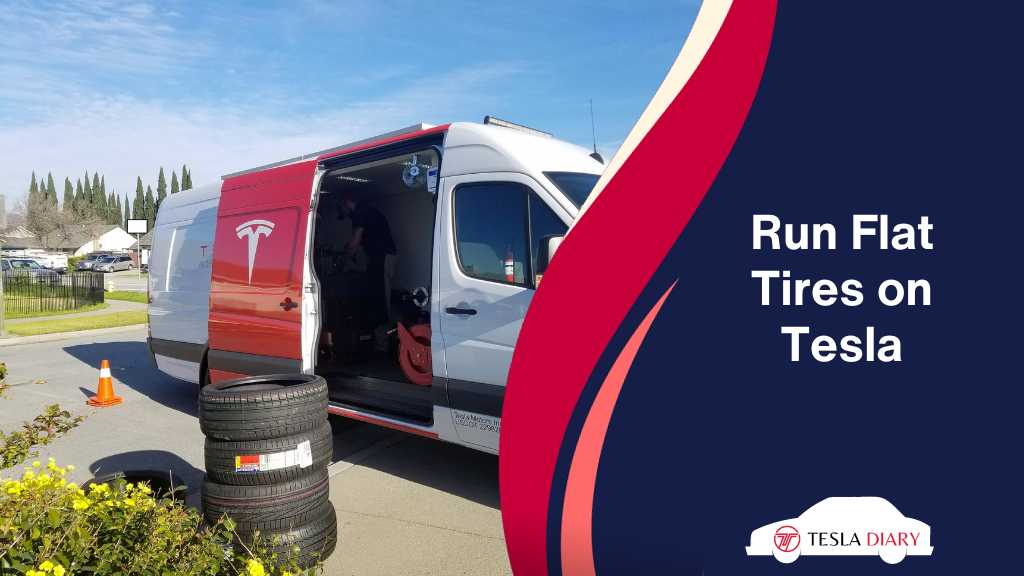When it comes to equipping your Tesla with tires, there are several options to consider.
One question that often arises is whether it’s possible to put run-flat tires on a Tesla.
In this article, we will explore the advantages and disadvantages of run-flat tires, discuss whether you can safely drive with a flat tire on a Tesla, and delve into the cost of Tesla’s flat tire service.

Can I Put a Run-Flat Tire on My Tesla Model 3, S, X, or Y?
Yes, you can put run-flat tires on your Tesla. However, Tesla doesn’t recommend doing so, because it compromises with ride comfort and range. Plus, Tesla has a pretty good roadside assistance service that can rescue you in case you encounter with flat tire issue.
Either way, if you still want to give it a shot, let’s discuss what you get with run-flats and what you compromise-
Advantages of Run-Flat Tires
1. Safety:
Run-flat tires can provide an added layer of safety as they allow you to maintain control of your vehicle even in the event of a tire puncture. This can be particularly important in emergency situations.
2. Convenience:
With run-flat tires, you don’t need to immediately stop and change a flat tire or call for roadside assistance.
You can continue driving to a safer location or your destination, saving time and hassle.
3. No Spare Tire:
Since run-flat tires eliminate the need for a spare tire, you can free up storage space in your Tesla’s trunk.
This can be especially valuable in electric vehicles where any weight reduced means you get extra mileage.
Disadvantages of Run-Flat Tires
1. Ride Comfort:
Run-flat tires typically have stiffer sidewalls to support the weight of the vehicle when deflated.
This can result in a harsher ride compared to regular tires, which may not be as comfortable for some drivers.
2. Limited Range:
While run-flat tires allow you to drive for a limited distance after a puncture, they are not a long-term solution.
You will still need to replace or repair the damaged tire as soon as possible.
3. Cost:
Run-flat tires tend to be more expensive than regular tires. Additionally, they may wear out faster due to their reinforced construction.
Can You Drive With a Flat Tire on a Tesla?
Tesla vehicles are equipped with a tire pressure monitoring system (TPMS) that alerts you when tire pressure is significantly low.
While you can technically drive with a flat tire on a Tesla for a short distance, it is not recommended. Doing so can cause damage to the tire and rim, affecting your safety and potentially leading to more extensive and costly repairs.
It is advisable to pull over to a safe location and address the issue promptly if you receive a TPMS alert.
How Much Does Tesla Charge for Flat Tire Service?
Tesla offers a Roadside Assistance program that includes flat tire service. The cost of this service may vary depending on your Tesla model, location, and whether you have an active Tesla service plan or are within the warranty period.
| Service | Cost |
|---|---|
| Tesla Roadside Assistance provided within warranty | Free service + $350-$400 |
| Paid Tesla Roadside Assistance | $400-$550 |
| Tesla Mobile Service | $80 for patch, $400-$550 for replacement. |
While the exact pricing details can change over time, Tesla owners typically find the flat tire service to be competitively priced, and it offers the convenience of having trained Tesla technicians handle the tire replacement or repair.
Final Words
It is possible to put run-flat tires on a Tesla, but it’s essential to carefully consider the advantages and disadvantages, as well as compatibility with your specific Tesla model and tire size.
Additionally, driving with a flat tire on a Tesla is not recommended, and Tesla provides a flat tire service for your convenience.
When it comes to tire choices and maintenance, consulting with a tire professional and adhering to Tesla’s guidelines can help you make informed decisions and ensure the safety and performance of your electric vehicle.

